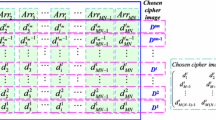Abstract
In this paper, two new one-dimensional chaotic functions are designed using Devaney chaotic definition. And a dynamically shifting compound chaotic function is constructed based on the two new one-dimensional chaotic functions. The properties of compound chaotic functions are also proved. A new feedback image encryption algorithm is designed using the new compound chaos and an image pixel permutation, 3D baker scheme is described in detail. In the scheme, a new dynamic block dividing the 3D baker is put forward using the compound chaotic map, and the key space expands. In order to produce avalanche effect and sensitivity of cipher to plaintext, the round times are designed to control the cycle. The entropy analysis, difference analysis, weak-key analysis, statistical analysis, cipher random analysis, and cipher sensibility analysis depending on key and plaintext are introduced to test the security of the new scheme of image encryption. The tests show that the image encryption method passes the random tests of NIST FIPS 140-2(2001) and SP 800-22 standards. This paper also solves the problem of short periods and low precision of one-dimensional chaotic function by perturbation.
Similar content being viewed by others
References
Chen G R, Mao Y. Chaos-based Image Encryption. Handbook of Computational Geometry for Pattern Recognition. Berlin: Springer-Verlag, 2005. 231–265
Mao Y B, Chen G, Lian S G. A novel fast image encryption scheme based on the 3D chaotic baker map. Int J Bifurcat Chaos, 2004, 14: 3613–3624
Zhang Y W, Wang Y M, Shen X B. Chaos-based image encryption algorithm using alternate structure. Sci China Ser F-Inf Sci, 2007, 50: 334–341
Li H D, Feng D G. Composite nonlinare discrete chaotic dynamical systems and keyed hash functions. Chin J Comput, 2003, 26: 460–464
Tao X, Liao X F, Tang G P. A novel block cryptosystem based on iterating a chaotic map. Phys Lett A, 2006, 34: 109–115
Zhang W T, Qing S H, Wu W L. Security evaluation for a class of block ciphers based on chaotic maps (in Chinese). J Softw, 2003, 14: 512–517
Li P, Li Z, Wolf G A, et al. Analysis of a multiple-output, pseudo-random bit generator based on a spatiotemporal chaotic system. Int J Bifurcat Chaos, 2006, 16: 2949–2963
Huang F J. Information security research based on discrete chaotic theory (in Chinese). Dissertation for the Doctoral Degree. Wuhan: Huazhong Science and Technology University, 2005. 1–10
Li S J, Zheng X. On the security of an image encryption method. Proc 2002 Int Conf Image Process, 2002, (2): 925–928
Chuang T J, Lin J C. A new multi-resolution approach to still image encryption. Patt Recognit, 1999, 9: 431–436
Chen G R, Mao Y B, Charles K C. A symmetric image encryption scheme based on 3D chaotic cat maps. Chaos Solit Fractal, 2004, 21: 749–761
Xiang T, Liao X F, Tang G P, et al. A novel block cryptosystem based on iterating a chaotic map. Phys Lett A, 2006, 349: 109–115
Lian S G, Mao Y B, Wang Z Q. 3D extension of Baker map and its application to multimedia information encryption (in Chinese). Control Decision, 2004, 19: 714–717
Li S J. Chaos-based Image and Video Encryption. Chapter 4. Multimedia Encryption Handbook. Furht B, Kirovski D, eds., New York: CRC Press, 2005. 133–168
Zhao G, Fang J Q, Yan H, et al. Design of changeable P-box and two modules structure block cryptosystem based on chaos. In: Proceedings of APWCCS, 2007. 174–183
Lu K, Sun J H, Ouyang R B, et al. Chaotic Dynamics (in Chinese). Shanghai: Shanghai Translation Press, 1990. 17–51
Tong X J, Cui M. Image encryption with compound chaotic sequence cipher shifting dynamically. Image Vision Comput, 2008, 26: 843–850
Hao B L. Staring from Parabola-Chaotic Dynamics Introduction (in Chinese). Shanghai: Shanghai Education Press, 1993. 122–123
Hone B, Tang Q Y, Yang F S, et al. ApEn and cross-ApEn: property, fast algorithm and preliminary application to the study of EEG and cognition (in Chinese). Signal Process, 1999, 15: 100–108
Zhou H, Ling X T. Realizing finite precision chaotic systems via perturbation of m sequences (in Chinese). Acta Electron Sin, 1997, 25: 95–97
Rukhin A, Soto J. A Statistical Test Suite for Random and Pseudorandom Number Generators for Cryptographic Applications. NIST Special Publication 800-22, May. 2001. 1–115
Author information
Authors and Affiliations
Corresponding author
Rights and permissions
About this article
Cite this article
Tong, X., Cui, M. Feedback image encryption algorithm with compound chaotic stream cipher based on perturbation. Sci. China Ser. F-Inf. Sci. 53, 191–202 (2010). https://doi.org/10.1007/s11432-010-0010-3
Received:
Accepted:
Published:
Issue Date:
DOI: https://doi.org/10.1007/s11432-010-0010-3




